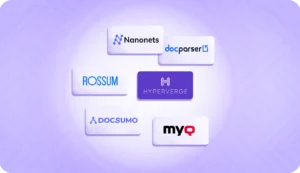Whether you are a developer, a business owner, or an individual user, you know that dealing with data is a headache.
The challenges are numerous, from manual data entry to inaccurate data processing. To resolve such challenges, optical character recognition (OCR) technology is the best option.
The IMARC Group expects the OCR market to reach US$40.8 billion by 2032, with a CAGR of 14.2% from 2024 to 2032.
AI-powered OCR integration APIs allow you to extract data from structured and unstructured documents with 95%+ accuracy. This saves your time and eliminates the chances of manual errors.
However, the key concern is that a single search for APIs yields a wide range of options offering automated data extraction, making it difficult to choose the right OCR API.
To address this concern, we have curated a detailed list of the best OCR APIs. This list will help you choose the API that best suits your document processing needs.
Let’s get started.
How does OCR API work?

An OCR API is a powerful tool that automates data extraction from various documents and images to help businesses digitize and analyze their important data. Let’s examine how this API integrates and the process involved in data capture.
- You can set up the OCR API in your system by obtaining an API key from the provider and configuring the necessary settings.
- Send a request to the OCR API along with the document containing the text you want to extract.
- Carry out the preprocessing of the image or document to improve text recognition by adjusting contrast and brightness.
- Analyze the document using the API’s OCR capabilities to identify the shapes and patterns corresponding to specific characters and words.
- Post-process and send the recognized text back to your system in a usable format after spell-checking and formatting.
- Use the extracted text in different ways per your requirements, such as database storage or application use.
Now, let’s understand the process we follow to list the APIs.
How we analyzed and selected the best OCR API for data extraction
Our team followed a manual process for evaluating the top OCR API available. The process involved analyzing 20+ OCR API options that specialize in automating document processing. We compared each API review and ratings from platforms like G2 and Capterra.
We then shortlisted the top 10 APIs based on accuracy, language support, integration, cost, scalability, and documentation. This process ensures our list includes the best APIs for your document processing requirements.
Overview of the top 10 OCR APIs for data extraction
Here is the table with an overview of all the best OCR APIs based on G2 reviews and ratings and free trial availability.
| Optical Character Recognition (OCR) APIs | G2 Reviews & Ratings (Out of 5) | Free Trial Availability |
| 4.7 (52 Reviews) | 30-day free trial in a sandbox environment. | |
| 4.7 (51 Reviews) | 14-day free trial. | |
| 4.8 (54 Reviews) | 14-day free trial. | |
| 4.4 (85 Reviews) | No free trial, but the first 1000 requests are free each month for specific features. | |
| 4.8 (72 Reviews) | No free trial, but offers a plan with pay-as-you-go pricing. | |
| 4.4 (49 Reviews) | Free trial available with 1,000 operations per month | |
| 4.9 (46 Reviews) | Free trial available with 100 pages. | |
| 4.1 (46 Reviews) | No free trial, but offers a Free plan with 5,000 free transactions per month. | |
| 4.5 (21 Reviews) | Free trial available for three months as part of the AWS Free Tier. | |
| 4.4 (10 Reviews) | No free trial is available. |
A detailed list of the 10 best OCR APIs to automate data extraction
Here is the list of the top 10 best OCR APIs that help streamline document processing.
1. HyperVerge

About HyperVerge
HyperVerge is a leading OCR API known for its 95%+ accuracy in extracting data from documents. This AI-powered OCR engine is template-agnostic and helps process structured documents like ID cards and official records as well as unstructured documents like invoices and bank statements. Such flexibility makes HyperVerge an ideal option for businesses looking to optimize their document processing workflows.
HyperVerge OCR API uses a 13-year-trained AI model to deliver exceptional accuracy and reliability. The tool supports 150 languages, making it an excellent choice for global operations. The API’s ability to manage various document formats, such as PDFs and images, ensures you can easily import and process documents from multiple sources with minimal hassle.
The intelligent document processing capabilities help automate manual processes and reduce turnaround times, enabling rapid go-live times and improving operational efficiency. The API complies with global regulations and maintains a secure environment by encrypting user details and performing a detailed audit trail of every application.
Key features of HyperVerge
Here are the key features of HyperVerge OCR.
- Advanced font recognition: Extracts printed and handwritten text from different fonts and typefaces, including those on print posters, to ensure consistent data capture with various documents.
- Smooth integration: Easily integrates with several platforms and applications. This allows quick deployment into web and mobile applications with minimal workflow interruptions.
- Versatile output formats: Offers extracted data in JSON, XML, and CSV to facilitate easy integration into different systems and databases.
- Image preprocessing: Improves image quality with noise reduction and contrast adjustment to ensure high accuracy in text recognition.
- Secure encryption: Protects sensitive information with strong encryption in transit and at rest. It also complies with global data protection regulations like GDPR.
HyperVerge pricing
HyperVerge provides different pricing plans for various businesses, from startups to enterprises. Let’s examine each plan in detail.
| Start plan (Startups) The Start plan includes a free trial and easy integration within 4 hours. It also offers tools to view and manage verification for a one-month period. | Grow plan (Mid-size companies) The Grow plan involves everything covered in the Start plan, and it also includes an end-to-end ID verification suite, access to AML checks, central database checks, and customized business workflows. | Enterprise plan (Enterprise-level organizations) The Enterprise plan involves all the features and offerings from the Grow plan, along with a custom price structure and collaborative tools. |
What people say about HyperVerge
Client video testimonial
The adoption of HyperVerge is widely spread, serving popular clients like HomeCredit, LTFS, PDAX, Freo, ZestMoney, and Ahamove. One of the popular clients is HomeCredit, a leading international consumer finance provider. The advanced fuzzy match logic of the HyperVerge OCR API reduced HomeCredit’s error rates by 50% and cut down application processing time by a third. Here is the feedback received from the client.
Want an accurate OCR API for your document processing needs?
HyperVerge OCR API helps extract text with 95%+ accuracy from global ID cards and official documents Get a free Demo2. Docsumo

About Docsumo
Docsumo API is exceptional at providing capabilities to automate document data extraction and processing. It supports various document types which ensures adaptability with diverse industries and use cases. Also, the accuracy in extracting data like dates, amounts, and names is remarkable.
For developers, it’s easy to integrate Docsumo’s functionalities into their current systems with RESTful architecture and support for multiple programming languages like Python and Curl. The accessibility to language bindings simplifies integration efforts which accelerates the adoption of this API within diverse organizations.
Docsumo Pricing
Docsumo pricing starts at $500+/month for the Start-Up Plan with pre-trained APIs for invoices & purchase orders and goes up to custom pricing for the Enterprise Plan with auto-classification of documents & unlimited users.
Key features of Docsumo
- Document type: The API supports a variety of document types like invoices, identification documents, and financial statements which helps users extract key data from different document formats.
- Accurate data extraction: It uses machine learning algorithms to ensure accurate extraction of information like dates, amounts, names, and addresses.
- Easy integration: Integrates flawlessly with existing applications with RESTful architecture and also supports Python and Curl.
- Fraud checks: Includes built-in fraud checks to verify the authenticity of the documents. It helps eliminate the risk of processing illegitimate documents by detecting fraudulent characteristics like monochrome images, scanned documents, or photos of photos.
Pros of Docusumo
- Users report that the reduction in manual workload is about 80-90%.
- Offers great experience for both developers and end-users with reliable automation results and access to advanced tools.
- The responsiveness and support from the Docsumo team is way superior.
Cons of Docusumo
- Setting up the system is a bit time-consuming, specifically when processing different document types.
- Users have experienced issues like unusual formatting in Excel exports and limitations in keyboard navigation during document review.
3. DocuClipper

About DocuClipper
DocuClipper API excels at financial document management by offering high precision in extracting valuable data. The API supports financial documents like bank statements, invoices and tax forms to extract data. It simplifies the extraction process with its intuitive interface and powerful machine-learning algorithms.
The support that DocuClipper API offers for categorizing bank transactions and automating invoice processing is remarkable in helping users organize and analyze their financial data. This not only drives productivity but also improves precision in data extraction by reducing manual errors.
DocuClipper Pricing
The pricing for DocuClipper starts at $27/month for the Starter plan, which includes capturing data from invoices and receipts, and ends at custom pricing for the Enterprise plan, which includes unique requirements and high conversion volumes.
Key features of DocuClipper
- Data extraction: Consists of advanced algorithms that ensure precise data extraction from bank statements, invoices, and tax forms.
- Flexible export options: Offers flexible export options that allow the export of data in different formats like JSON, CSV, and QBO.
- Asynchronous processing: Helps manage large volumes of documents without compromising the speed or performance of the platform.
- Automated categorization: Automatically categorizes bank transactions to gain valuable insights into financial activities and improve decision-making.
Pros of DocuClipper
- Users report that it’s easy to upload PDF documents and convert them to various formats like Excel, CSV, and QBO.
- Offers high accuracy in data extraction, with users reporting up to 98% accuracy.
- Support and instructional materials available are helpful.
Cons of DocuClipper
- Small businesses that require the tool for occasional projects express dissatisfaction with the subscription model.
- New users require a brief period of adjustment to use the tool to its optimal capacity.
4. Google Cloud Vision API
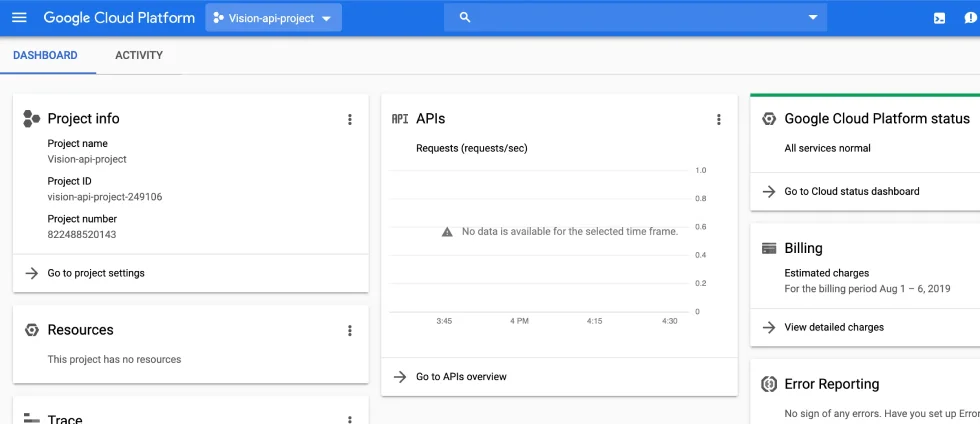
About Google Cloud Vision API
Cloud Vision API assists in interpreting and analyzing visual data with its accurate solution for extracting data from images, documents, and videos. The API is easy to integrate with Google Cloud’s pre-trained computer vision machine learning models, allowing developers to automate vision tasks and simplify analysis.
Cloud Vision API provides no code model training and a cost-effective environment, which makes it an ideal option for small-scale projects and enterprise applications. The API provides easy and quick integration with existing applications. Along with Vision AI, Google also offers Document AI.
This is a powerful platform that combines computer vision and natural language processing to convert unstructured data into structured information.
Google Cloud Vision API Pricing
Cloud Vision API pricing starts with the first 1000 requests free monthly and ends with features priced at $3.50 per 1000 requests for Web Detection and $2.25 per 1000 requests for Object Localization.
Key features of Google Cloud Vision API
- Image labeling: Helps developers automatically identify and label objects from the images, which enhances the developers’ understanding of visual content.
- Face and landmark detection: Detects faces and landmarks from the images or documents. This feature assists with applications like facial recognition and image tagging.
- Document analysis: Analyzes the content and structure of the documents or images, which helps with document understanding, data extraction, and information synthesis.
- Explicit content tagging: Provides tools for detecting and tagging explicit content from the images to ensure the application maintains quality content standards and complies with regulations.
Pros of Google Cloud Vision API
- Simple to integrate with several applications using REST and RPC APIs.
- Offers access to pre-trained models, which saves time and effort in model training.
- For users, understanding and implementing the API becomes easier with its user-friendly documentation.
Cons of Google Cloud Vision API
- Users are unable to customize or train models for specific use cases.
- Some users with a requirement for large-scale image processing find the pricing model expensive.
5. Nanonets

About Nanonets
Nanonets provides one of the best OCR APIs to integrate into existing systems and applications. Their versatile API supports several programming languages like Shell, Ruby, Golang, Java, C#, and Python.
Having such capabilities ensures smooth integration into diverse development environments. Nanonets API offers detailed documentation and built-in code samples that help developers develop OCR models customized to specific needs.
The user-friendly approach to model creation and training makes Nanonets API stand out in the competition. Managing models through intuitive endpoints for uploading images, training models, and retrieving predictions becomes easier. Their secure API ensures all requests are authenticated and encrypted, which provides peace of mind when managing sensitive data.
Nanonets Pricing
Nanonets offers a free Starter plan with pricing based on usage after the first 500 pages and an Enterprise plan with custom pricing and automation solutions.
Key features of Nanonets
- Model management: Create, train, and manage OCR models using various endpoints to manage different stages of the model lifecycle.
- Flexible integration: Supports various programming languages and offers thorough code samples for easy and quick integration.
- Secure API requests: Ensure that all API requests are authenticated to maintain data security and integrity.
- Detailed documentation: Offers detailed documentation and resources like Postman collections and example code to help users get started quickly.
Pros of Nanonets
- Offers customized solutions without requiring extra time and resources from internal engineers.
- Several users command Nanonets for the intuitive and easy-to-navigate UI it consists.
- The integration of the API with the existing workflow is remarkable.
Cons of Nanonets
- Pricing is a concern for those operating within budget constraints.
- The trial period duration is a bit shorter for some users.
6. Clarifai

About Clarifai
Clarifai is an all-in-one platform that specializes in providing optical character recognition API. It enhances text analysis by extracting detailed metadata and insightful information from images and videos. The API helps enterprises automate document processing using advanced machine learning models.
Clarifai OCR API is an ideal choice for businesses looking to improve document understanding and text extraction capabilities. The API also offers multilingual support and integrates easily into the existing systems and applications.
Clarifai Pricing
Clarifai pricing starts with a free API plan that offers 1,000 free operations per month and ends with an Enterprise plan that includes custom QPS, advanced security, role-based access, and volume discounts.
Key features of Clarifai
- Multiple language support: Detects and recognizes text in multiple languages within a single document. This provides unmatched versatility for diverse linguistic contexts.
- Handwritten text recognition: Accurately interprets handwritten text using advanced models like TrOCR. This helps digitize handwritten notes and historical documents.
- Pre-trained specialized model: Offers pre-trained specialized models for document understanding and barcode detection.
- Structured output format: Provides output in JSON format that helps integrate the extracted text easily into several applications.
Pros of Clarifai
- Users experience that the tutorial support for image-to-text generation models is outstanding.
- The API fits smoothly into existing workflows.
- Excels in processing text in multiple languages with ease.
Cons of Clarifai
- Some users say the user interface and user experience need improvements.
- A few users faced issues with the API’s responsiveness.
Need a reliable OCR solution for your business?
Choose HyperVerge. Providing exceptional accuracy in extracting data with its 13-year-trained AI model for OCR. Get a free Demo7. Base64.ai
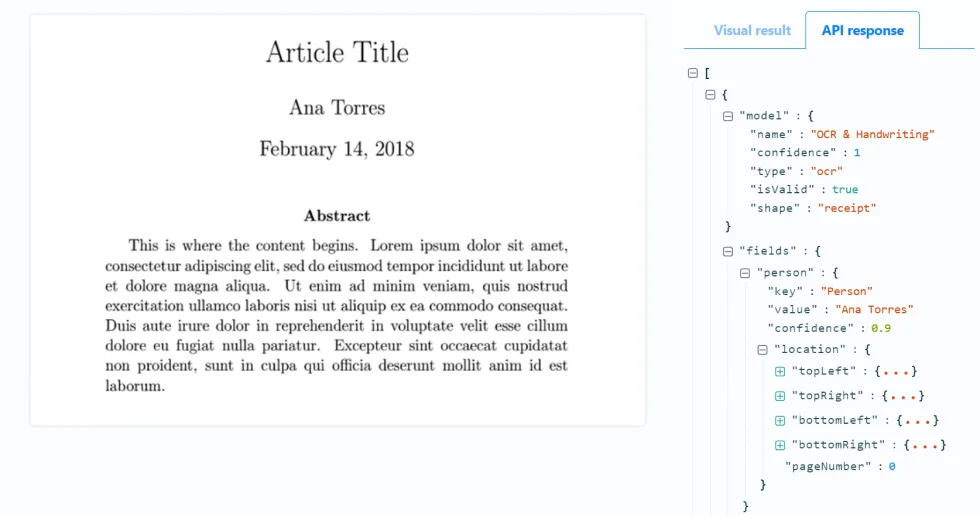
About Base64.ai
Base64 provides an exceptional OCR API for document processing and data extraction. The API uses multi-layer artificial intelligence to extract accurate data even though the document is blurred or the text is misaligned. The API’s ability to clean up and validate results and translate technical codes into machine-readable text.
Base64 offers remarkable flexibility and scalability. With its cloud-based approach, the API eliminates the need for hardware. It supports various document types and automatically recognizes and organizes documents into categories. Also, Base64 offers constant support and resources to ensure users can maximize the API’s potential and stay updated with the latest functionality.
Base64.ai Pricing
Base64.ai pricing starts at $300/month for the Scale plan and goes up to $2,500/month for the Success plan, with extra pages charged at $0.25 per page.
Key features of Base64.ai
- File format support: It supports a variety of file formats, such as JPEG, PNG, GIF, DOC, DOCX, XLS, XLSX, PPT, PPTX, PDF files (both digital and image-only), and ZIPs.
- Error handling: This consists of capabilities with clear status codes and messages, such as 200 for success, 401 for invalid authentication, and 500 for internal errors.
- Handwriting support: This option involves handwriting support by default. This ability enables accurate extraction of handwriting text without any extra configuration.
- Data validation: Performs thorough validation on the extracted data to protect from fraud and reading errors.
Pros of Base64.ai
- The setup process is straightforward and easily integrates with existing systems.
- Users find Base64.ai to be a cost-effective option when compared to other OCR API solutions.
- Offers 24/7 live customer support which is something that users require.
Cons of Base64.ai
- Users must have a slight learning curve when creating customized templates for unique document structures.
- There are instances where the user finds glitches with handwritten recognition.
8. Microsoft Azure AI Vision
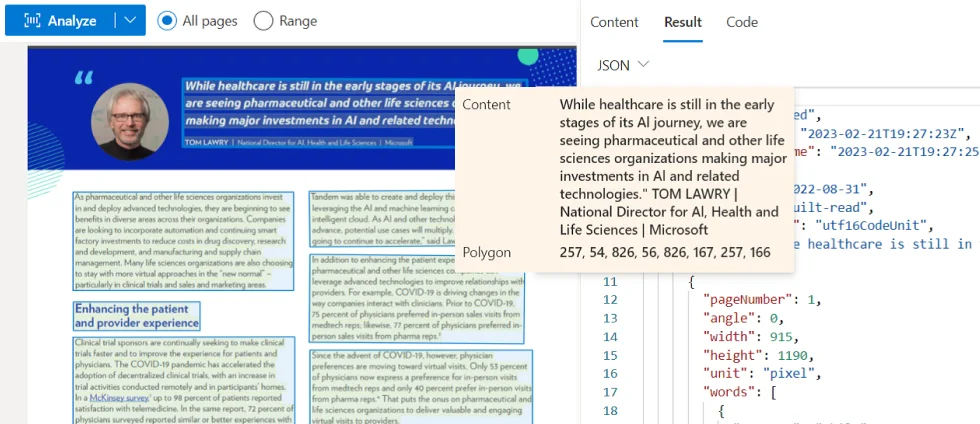
About Microsoft Azure AI Vision
Azure AI Vision offers a reliable OCR API with superior performance and accuracy in extracting data from printed or handwritten documents. The API uses advanced deep-learning algorithms to ensure that efficiency remains ideal. Supports various documents like business documents, invoices, and posters.
Azure AI Vision’s OCR API stands out because of its deployment flexibility. It caters to various business needs regarding data security and compliance by offering availability in cloud service and an on-premises Docker container. This flexible approach allows businesses to integrate OCR technology into their existing workflows easily.
Microsoft Azure AI Vision Pricing
The pricing is based on image analysis, spatial analysis, video retrieval, commitment tiers, and disconnected containers. Contact Microsoft Azure to get the custom pricing.
Key features of Microsoft Azure AI Vision
- Accurate text extraction: Extracts text from several surfaces like business documents, receipts, and whiteboards even for printed or handwritten text.
- Multi-language support: Supports multiple languages for both handwritten and printed text like English, French, German, Chinese, and Japanese.
- Synchronous and asynchronous API: Provides real-time and batch processing capabilities to serve diverse performance and workflow requirements.
- IDP integration: Enhances text extraction by adding structure and insights like relationships, key values, and entities, for detailed document analysis.
Pros of Microsoft Azure AI Vision
- Developers get access to advanced algorithms for processing images.
- A highly accurate and efficient tool for extracting text from images, with user-friendly documentation.
- Image processing with this API is way better than the conventional available technique.
Cons of Microsoft Azure AI Vision
- Some users have noted that the API is a bit pricey.
- One user reported that errors are faced when passing frames from a live feed.
9. Amazon Textract

About Amazon Textract
Amazon Textract is a cloud-based OCR API that automatically detects and extracts text and key data from documents and PDF files. Using the advanced OCR model, the tool offers wide capabilities, from simple data extraction to identifying the contents of fields in forms and information stored in tables. This helps the solution handle various documents like financial reports, medical records, invoices, and receipts.
The tool offers strong capabilities for automating data entry. It also easily integrates with RPA workflows using connectors from UiPath and other bots. Textract supports human review integration through Aamzon Augmented AI. Textract is a scalable and cost-effective solution for streamlining and automating document handling tasks.
Amazon Textract Pricing
Amazon Textract’s pricing starts at $1.50 per 1,000 pages for Detect Document Text API and ranges from $15.00 to $70.00 per 1,000 pages for Analyze Document API features.
Key features of Amazon Textract
- Key-value pair extraction: Detects and retains the context of key-value pairs in documents to facilitate easy import of extracted data into databases.
- Table extraction: Preserves the structure of data stored in tables. This makes it suitable for documents like financial reports and medical records.
- Handwriting recognition: Accurately extracts text from printed and handwritten text to manage free-form text and text embedded in tables and forms.
- Confidence scores: Provides confidence scores for all extracted data, which helps users to make better decisions about the reliability of the extracted information.
Pros of Amazon Textract
- The ability to extract key-value pairs and tables is outstanding.
- The tool is ready to use. It does not require custom training to get started.
- Users with varying data extraction needs find this tool’s pay-per-use model cost-effective.
Cons of Amazon Textract
- Sometimes the tool is unable to extract data from certain formats.
- Users report that the API response is not easy to understand and even the documentation lacks something.
10. ABBYY FlexiCapture
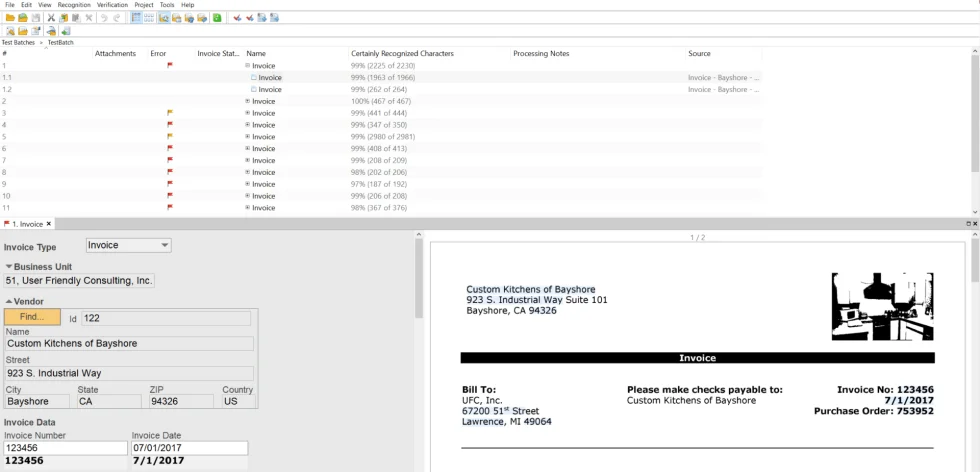
About ABBYY FlexiCapture
ABBYY FlexiCapture OCR API is an AI-powered OCR service that offers strong text recognition and image analysis capabilities. This OCR solution offers various deployment options, such as cloud and on-premise, to suit diverse business needs. ABBYY FlexiCapture allows businesses to digitize and process vast information easily by converting scanned images into machine-readable text from PDF, Word, or Excel files.
The ABBYY FlexiCapture OCR API delivers high performance and accuracy in text extraction from images, photos, and documents. This tool’s advanced image analysis capability makes it ideal for processing complex document layouts. Its ability to easily integrate within the current workflow also makes it valuable.
ABBYY FlexiCapture Pricing
Contact ABBYY FlexiCapture for current pricing.
Key features of ABBYY FlexiCapture
- Precise extraction: Extracts data with high precision from various document types like PDFs and images.
- Advanced image analysis: Detects complex document layouts like text, paragraphs, barcodes, tables, and more to facilitate detailed data analysis.
- Effortless integration: Quick implementation via REST API calls minimizes development efforts and enables efficient deployment with various platforms.
- Global language Recognition: Supports 200+ languages including handwritten text, and supports 26 barcode formats. This ensures compatibility with different document types and global language requirements.
Pros of ABBYY FlexiCapture
- Allows for image transformation that includes rotating and enhancing before performing OCR.
- Users find this tool to be beneficial for document classification and data extraction.
- The responsiveness of their supporting team is exceptional.
Cons of ABBYY FlexiCapture
- The lack of detailed documentation frustrates users.
- The high license cost of ABBYY FlexiCapture makes it expensive compared to its competitors.
After discussing the details of each API for document processing, let’s examine the popular applications of optical character recognition APIs.
Popular use cases of optical character recognition API
Here are the popular use cases of the optical character recognition API.
1. Finance
In finance, OCR APIs scan invoices, receipts, and financial documents and extract important data like transaction details, account numbers, and vendor information. This boosts efficiency and reduces manual errors. It also ensures accurate record-keeping and compliance with regulatory standards.
Recently, L&T Finance (LTF), a leading entity in the finance sector improved its operational efficiency by using HyperVerge’s OCR API. LTF reduced operational costs by 50% and improved their user experience by automating the extraction and categorization of non-standard documents through HyperVerge.
2. Insurance
OCR APIs serve the insurance industry by streamlining claims processing and policy management. By digitizing paper-based documents like insurance forms, contracts, and claims, insurers can easily extract key information like policy numbers, coverage details, and beneficiary information. This accelerates underwriting processes, improves customer services, and helps insurers make high-precision data-driven decisions.
3. Lending
Regarding the lending sector, OCR APIs optimize the loan application and approval process. By automating the extraction of borrower information from documents like bank statements, pay stubs, and identification proofs, lenders expedite application processing, assess creditworthiness more accurately, and mitigate the risk of fraud. This improves the entire customer experience, eliminates manual workload, and enables faster and better decision-making in loan disbursement.
4. Retail and eCommerce
OCR APIs allow retailers and eCommerce businesses to boost operational efficiency and customer experience. With the data extraction from documents like invoices, shipping labels, and product descriptions, retailers automate inventory management, order processing, and product cataloging. OCR helps in faster order fulfillment, improves inventory accuracy, and helps personalize customer’s shopping experiences.
5. Legal
In the legal industry, OCR API simplifies document management by converting physical legal documents, contracts, and court filings into searchable digital formats. This helps legal professionals search, review, and analyze text-based information. OCR API also helps accelerate case preparation, improves research accuracy, and facilitates collaboration with legal teams.
6. Healthcare
OCR APIs revolutionize administrative tasks and clinical workflows by digitizing patient records, medical reports, and insurance claims. The healthcare provider simplifies data entry, billing processes, and compliance documentation using OCR API. This reduces the administrative workload and improves patient care, allowing quick access to critical information.
How to choose the right OCR API for document processing
Here are some important steps to choose the right OCR API for document processing.
1. Define your document processing requirements
Considering the requirements is the most important part when opting for an appropriate OCR API. Before choosing an OCR API, look for the following document processing needs.
- Types of documents to be processed (invoices, receipts, and contracts)
- Key information to extract from documents (names, dates, and amounts)
- Document volume and frequency of processing
- Level of document complexity and variability
2. Assess accuracy and language support needs
Having high accuracy in document processing is important to avoid errors and interrupting your internal processes. When choosing the software, evaluate the OCR API’s performance in accurately recognizing text and data from different document types. Also, make sure that the API supports the language of your documents to avoid inaccuracies in text recognition.
3. Evaluate integration and compatibility with existing systems
When satisfied with the accuracy and language support, ensure that the chosen OCR API integrates easily with your existing systems, such as document management platforms or workflow automation tools. Check the tool’s compatibility with programming languages and frameworks that you use in your organization’s tech stack to optimize integration efforts and eliminate interruptions to existing workflows.
4. Examine advanced features and customization capabilities
Analyzing the tool’s functionalities is a critical step in the decision-making process. Neglecting this step leads to choosing an API that does not align with your specific requirements and objectives. Be sure to choose API with the following features:
- Image preprocessing tools for enhancing document quality before text extraction.
- Customizable data extraction rules to tailor the OCR process to specific document types.
- Support for various file formats like PDF, TIFF, and JPG to accommodate diverse document sources.
- Machine learning integration for improved accuracy and adaptability to different document layouts.
- Advanced layout analysis to accurately extract data from structured and unstructured documents.
5. Negotiate terms and make the final decision
After shortlisting the APIs based on the above steps, you need to negotiate the terms with the OCR service providers. These terms include pricing, service level agreements, and support options. When making your final decision, consider factors like scalability, reliability, and customer support responsiveness. You must opt for an OCR API provider that meets your current document processing requirements and aligns with your long-term goal.
Do you want to automate your data extraction process?
With intelligent document processing, HyperVerge makes it easy to extract data from complex documents like invoices, receipts, and contracts. Get a free DemoSelect the best OCR API for your business
Having a detailed list of APIs to choose from is a plus for businesses looking for a reliable API solution. The purpose of providing you with this list is to help you save time and effort searching for a trusted OCR API in this competitive market. Now you can choose the API that perfectly aligns with your document processing needs.
Reach out to HyperVerge to optimize your process and avoid wasting time searching for a reliable API. The tool consists of intelligent document processing that helps extract precise information from documents with an accuracy of around 95%. Schedule your free demo today.
Frequently asked questions
1. Is OCR API free or paid?
The availability and pricing model of OCR APIs vary between providers. Some offer free tiers with limited usage, while others operate on a subscription or pay-per-use basis. It is important to review the terms and conditions of each OCR API service to check if it aligns with your budget and requirements.
2. Which is the best OCR API?
The best OCR API varies based on various factors, such as accuracy, speed, language support, integration capabilities, and pricing. Selecting the best depends on the requirements. Several leading OCR APIs, such as HyperVerge OCR, Google Cloud Vision, Microsoft Azure AI Vision, and Amazon Textract, are the best in terms of everything from performance to features.
3. How accurate are OCR APIs in recognizing text from scanned documents?
The accuracy of OCR APIs in recognizing text from scanned documents depends on factors like the quality of the input images, the complexity of the text, language nuances, and the capabilities of the OCR engines. Generally, modern OCR APIs achieve high accuracy rates, often surpassing 90% accuracy under optimal conditions. However, it’s important to consider that errors still occur with handwritten or poorly scanned documents.
4. What are the benefits of using OCR APIs for document processing?
Here are the benefits of using OCR APIs for document processing.
- Uses advanced algorithms to recognize text from scanned images or documents.
- Reduces the time and effort required for manual data entry, speeding up document processing workflows.
- Eliminates the need for manual labor, which leads to cost savings for businesses in terms of time and resources.
- Handle large volumes of documents, which makes it a suitable option for businesses from small-scale to enterprise-level operations.
- Easily integrates into existing software applications and workflow.
5. What are the limitations of using OCR APIs for document processing?
Here are the limitations of using optical character recognition (OCR) APIs for document processing.
- Accuracy challenges arise from font variations, handwriting styles, poor image quality, and complex layouts.
- Limited language support affects accuracy for non-Latin scripts or less commonly used languages.
- Formatting issues occur, altering layout, spacing, or font styles of extracted text.
- Handling sensitive information poses privacy and security risks if proper precautions are not taken.
6. Can OCR APIs be customized to fit specific business requirements?
Many OCR APIs offer customization options to tailor the service to specific business requirements. This customization involves parameters like language settings, image preprocessing techniques, character recognition algorithms, or integration with software systems. Some providers also offer enterprise-grade solutions allowing customization and integration with existing workflows or applications.





